Analyzing the Impact of Global Recession on International Trade Policy
VerifiedAdded on 2023/06/15
|13
|1056
|250
Presentation
AI Summary
This presentation examines the impact of the 2008-2009 global recession on international trade theory and policy, with a particular focus on India's trade performance. It begins by outlining the key factors contributing to the Great Recession, including high interest rates, international banking crises, and declining productivity. The presentation then explores the recession's impact on developing countries, highlighting vulnerabilities related to commodity price fluctuations and financial market instability. A significant portion of the presentation is dedicated to analyzing the effects of the recession on India's economy, including the decline in industrial growth, reduced foreign exchange rates, and the collapse of exports in key sectors like IT, textiles, and petroleum products. The presentation also discusses the impact of the recession on specific sectors and concludes by noting the long-term challenges faced by sectors like agriculture and mineral oil in recovering from the economic downturn. Desklib provides access to similar solved assignments and past papers for students.
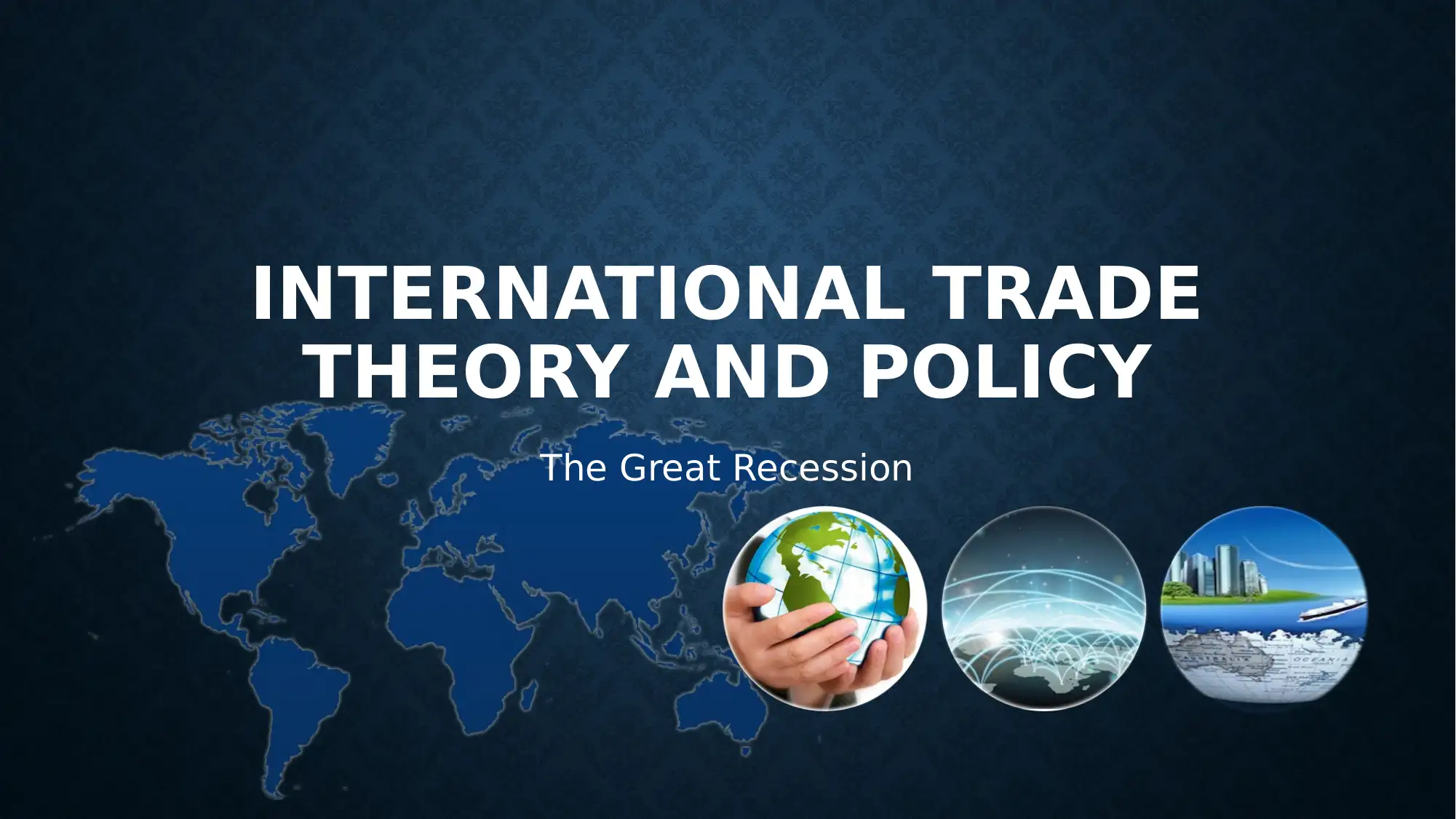
INTERNATIONAL TRADE
THEORY AND POLICY
The Great Recession
THEORY AND POLICY
The Great Recession
Paraphrase This Document
Need a fresh take? Get an instant paraphrase of this document with our AI Paraphraser
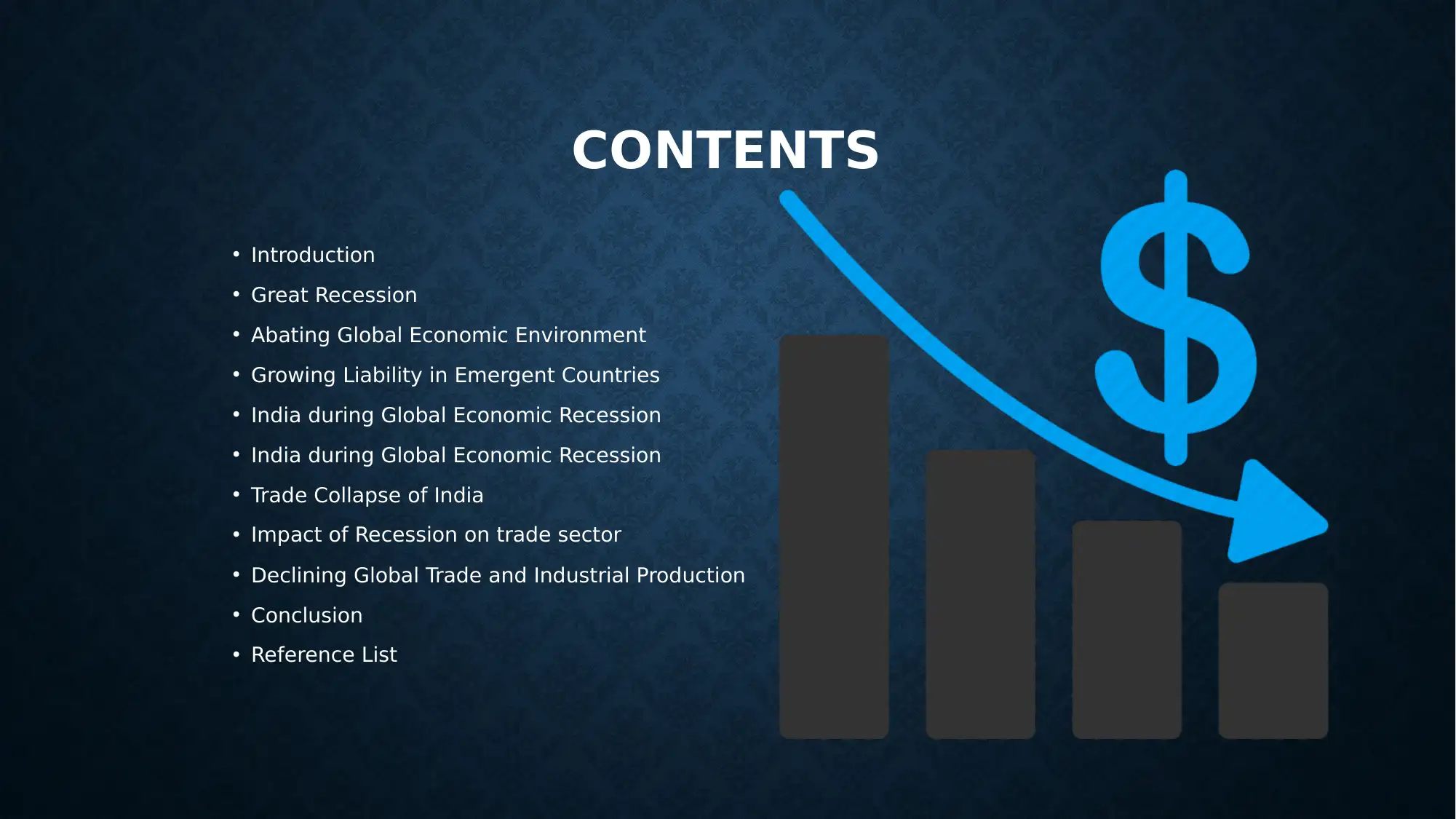
CONTENTS
• Introduction
• Great Recession
• Abating Global Economic Environment
• Growing Liability in Emergent Countries
• India during Global Economic Recession
• India during Global Economic Recession
• Trade Collapse of India
• Impact of Recession on trade sector
• Declining Global Trade and Industrial Production
• Conclusion
• Reference List
• Introduction
• Great Recession
• Abating Global Economic Environment
• Growing Liability in Emergent Countries
• India during Global Economic Recession
• India during Global Economic Recession
• Trade Collapse of India
• Impact of Recession on trade sector
• Declining Global Trade and Industrial Production
• Conclusion
• Reference List
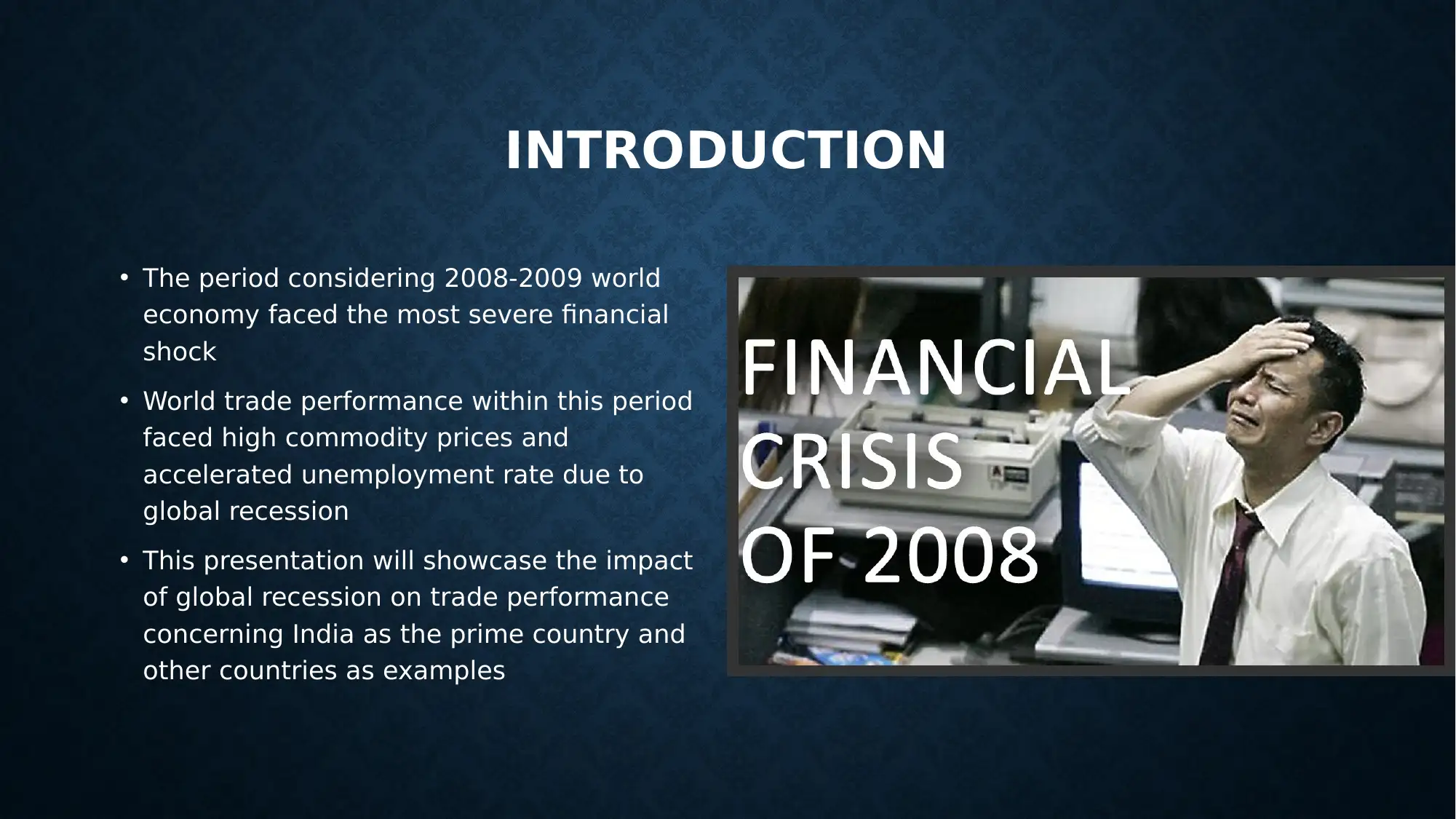
INTRODUCTION
• The period considering 2008-2009 world
economy faced the most severe financial
shock
• World trade performance within this period
faced high commodity prices and
accelerated unemployment rate due to
global recession
• This presentation will showcase the impact
of global recession on trade performance
concerning India as the prime country and
other countries as examples
• The period considering 2008-2009 world
economy faced the most severe financial
shock
• World trade performance within this period
faced high commodity prices and
accelerated unemployment rate due to
global recession
• This presentation will showcase the impact
of global recession on trade performance
concerning India as the prime country and
other countries as examples
⊘ This is a preview!⊘
Do you want full access?
Subscribe today to unlock all pages.

Trusted by 1+ million students worldwide
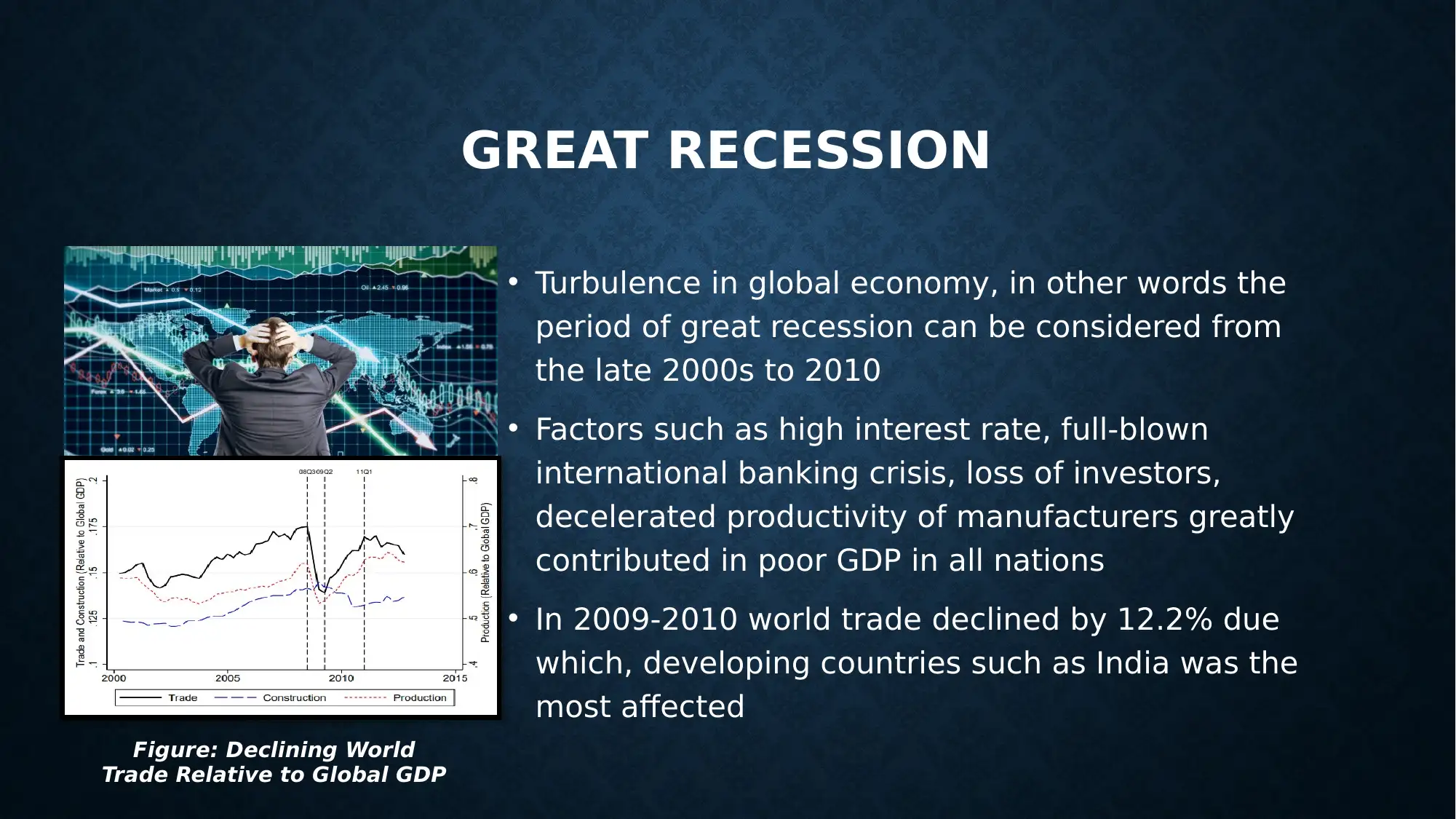
GREAT RECESSION
• Turbulence in global economy, in other words the
period of great recession can be considered from
the late 2000s to 2010
• Factors such as high interest rate, full-blown
international banking crisis, loss of investors,
decelerated productivity of manufacturers greatly
contributed in poor GDP in all nations
• In 2009-2010 world trade declined by 12.2% due
which, developing countries such as India was the
most affected
Figure: Declining World
Trade Relative to Global GDP
• Turbulence in global economy, in other words the
period of great recession can be considered from
the late 2000s to 2010
• Factors such as high interest rate, full-blown
international banking crisis, loss of investors,
decelerated productivity of manufacturers greatly
contributed in poor GDP in all nations
• In 2009-2010 world trade declined by 12.2% due
which, developing countries such as India was the
most affected
Figure: Declining World
Trade Relative to Global GDP
Paraphrase This Document
Need a fresh take? Get an instant paraphrase of this document with our AI Paraphraser
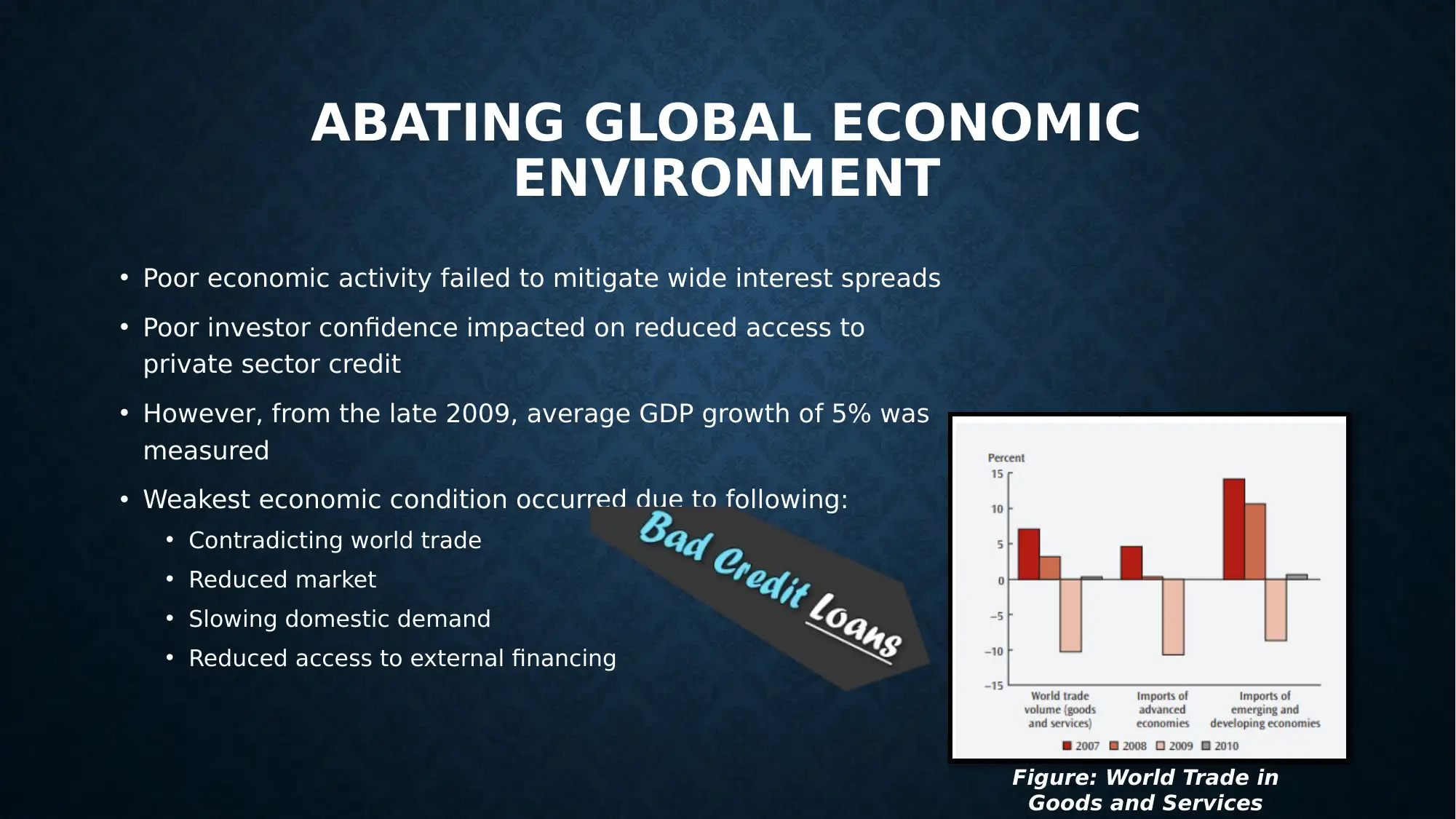
ABATING GLOBAL ECONOMIC
ENVIRONMENT
• Poor economic activity failed to mitigate wide interest spreads
• Poor investor confidence impacted on reduced access to
private sector credit
• However, from the late 2009, average GDP growth of 5% was
measured
• Weakest economic condition occurred due to following:
• Contradicting world trade
• Reduced market
• Slowing domestic demand
• Reduced access to external financing
Figure: World Trade in
Goods and Services
ENVIRONMENT
• Poor economic activity failed to mitigate wide interest spreads
• Poor investor confidence impacted on reduced access to
private sector credit
• However, from the late 2009, average GDP growth of 5% was
measured
• Weakest economic condition occurred due to following:
• Contradicting world trade
• Reduced market
• Slowing domestic demand
• Reduced access to external financing
Figure: World Trade in
Goods and Services
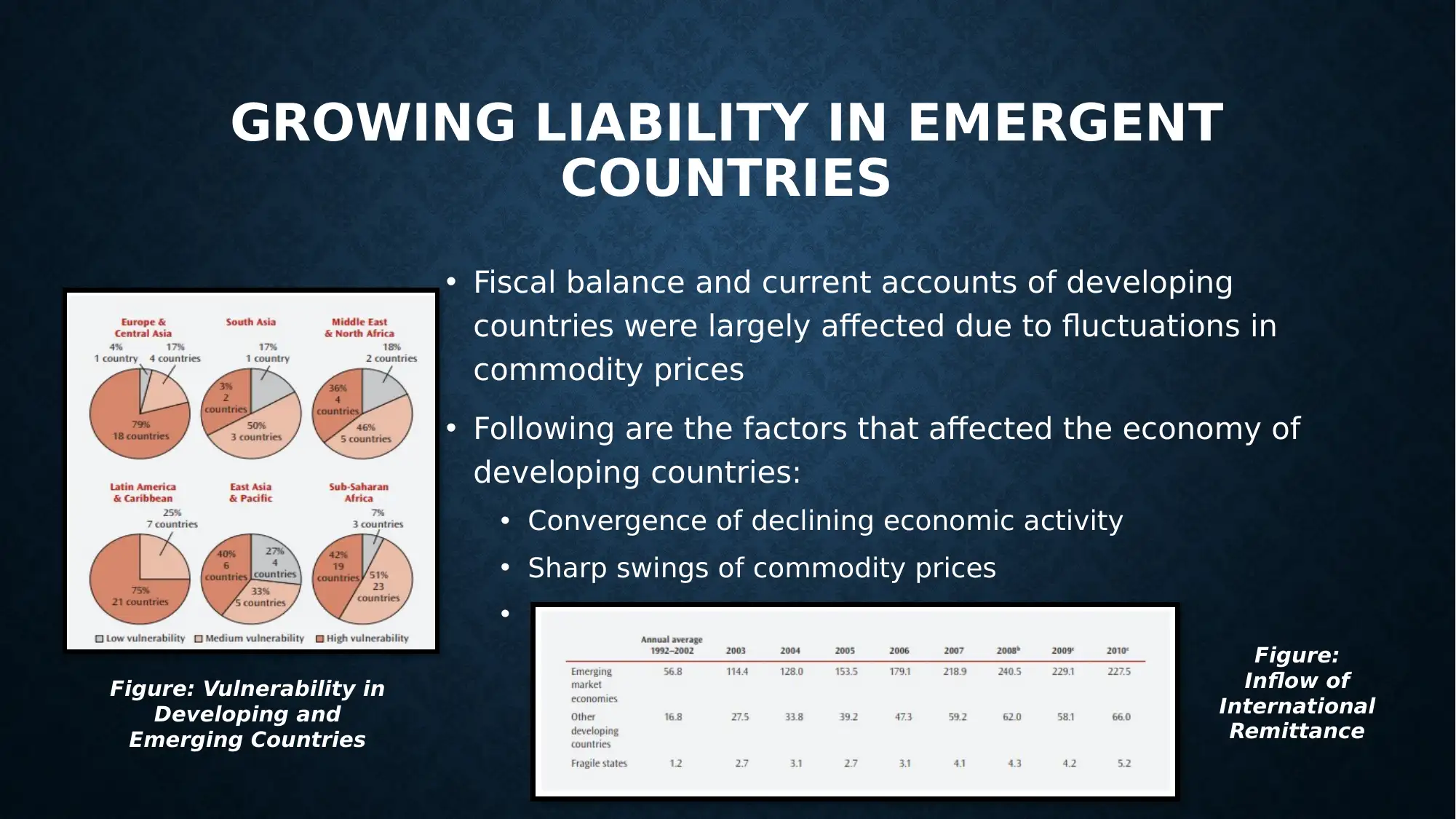
GROWING LIABILITY IN EMERGENT
COUNTRIES
• Fiscal balance and current accounts of developing
countries were largely affected due to fluctuations in
commodity prices
• Following are the factors that affected the economy of
developing countries:
• Convergence of declining economic activity
• Sharp swings of commodity prices
• Instability of financial market
Figure:
Inflow of
International
Remittance
Figure: Vulnerability in
Developing and
Emerging Countries
COUNTRIES
• Fiscal balance and current accounts of developing
countries were largely affected due to fluctuations in
commodity prices
• Following are the factors that affected the economy of
developing countries:
• Convergence of declining economic activity
• Sharp swings of commodity prices
• Instability of financial market
Figure:
Inflow of
International
Remittance
Figure: Vulnerability in
Developing and
Emerging Countries
⊘ This is a preview!⊘
Do you want full access?
Subscribe today to unlock all pages.

Trusted by 1+ million students worldwide
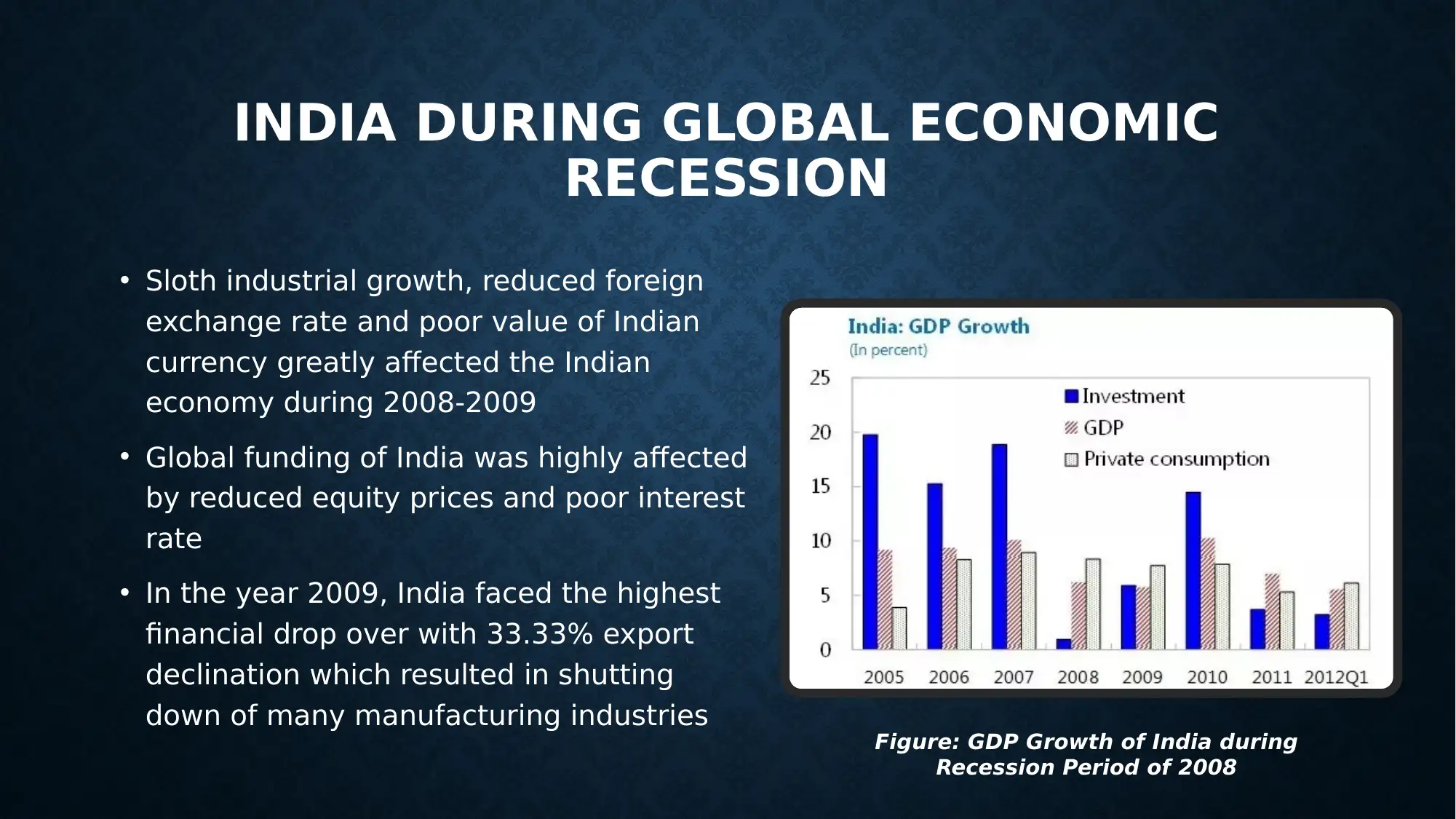
INDIA DURING GLOBAL ECONOMIC
RECESSION
• Sloth industrial growth, reduced foreign
exchange rate and poor value of Indian
currency greatly affected the Indian
economy during 2008-2009
• Global funding of India was highly affected
by reduced equity prices and poor interest
rate
• In the year 2009, India faced the highest
financial drop over with 33.33% export
declination which resulted in shutting
down of many manufacturing industries Figure: GDP Growth of India during
Recession Period of 2008
RECESSION
• Sloth industrial growth, reduced foreign
exchange rate and poor value of Indian
currency greatly affected the Indian
economy during 2008-2009
• Global funding of India was highly affected
by reduced equity prices and poor interest
rate
• In the year 2009, India faced the highest
financial drop over with 33.33% export
declination which resulted in shutting
down of many manufacturing industries Figure: GDP Growth of India during
Recession Period of 2008
Paraphrase This Document
Need a fresh take? Get an instant paraphrase of this document with our AI Paraphraser
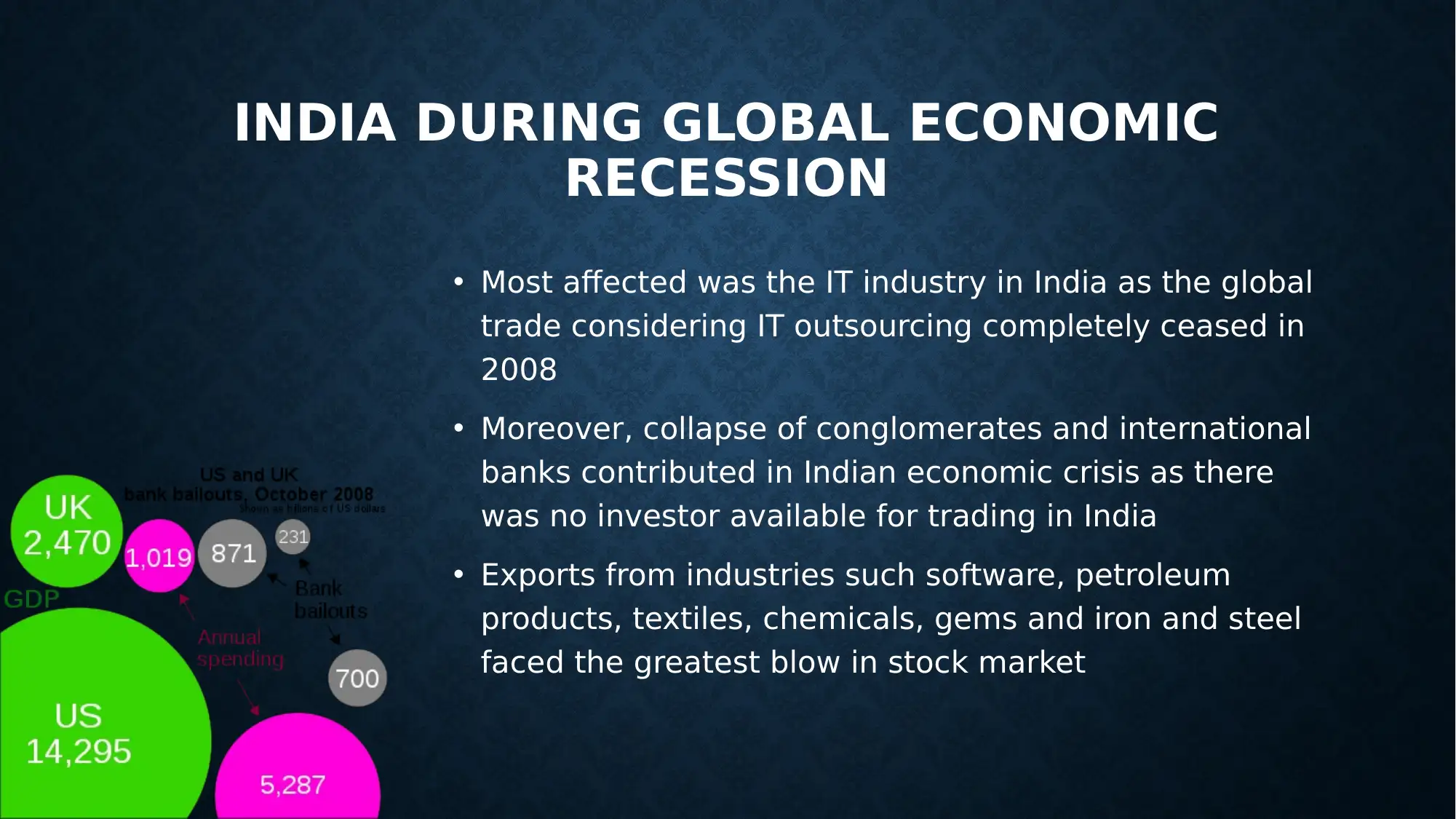
INDIA DURING GLOBAL ECONOMIC
RECESSION
• Most affected was the IT industry in India as the global
trade considering IT outsourcing completely ceased in
2008
• Moreover, collapse of conglomerates and international
banks contributed in Indian economic crisis as there
was no investor available for trading in India
• Exports from industries such software, petroleum
products, textiles, chemicals, gems and iron and steel
faced the greatest blow in stock market
RECESSION
• Most affected was the IT industry in India as the global
trade considering IT outsourcing completely ceased in
2008
• Moreover, collapse of conglomerates and international
banks contributed in Indian economic crisis as there
was no investor available for trading in India
• Exports from industries such software, petroleum
products, textiles, chemicals, gems and iron and steel
faced the greatest blow in stock market
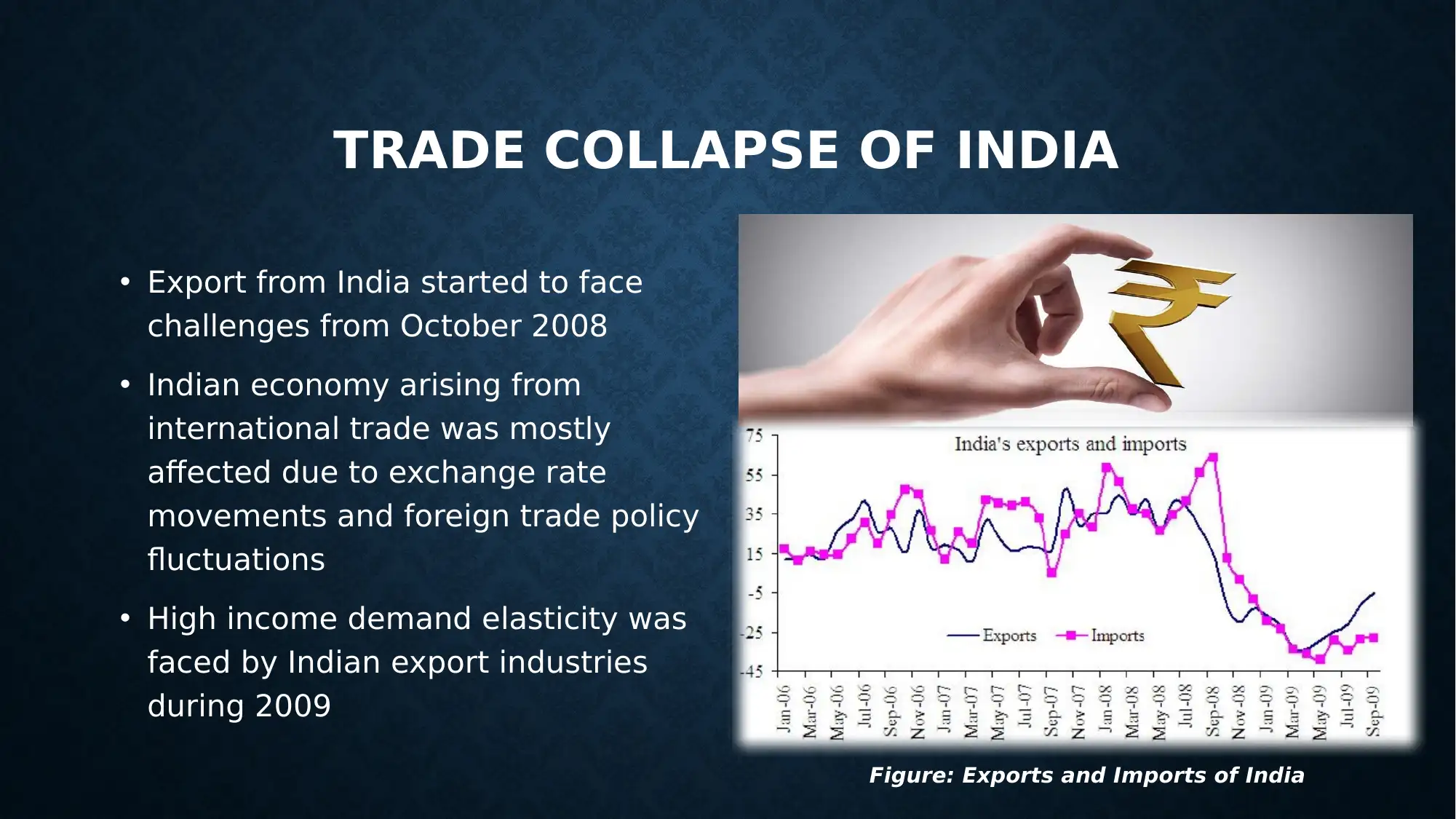
TRADE COLLAPSE OF INDIA
• Export from India started to face
challenges from October 2008
• Indian economy arising from
international trade was mostly
affected due to exchange rate
movements and foreign trade policy
fluctuations
• High income demand elasticity was
faced by Indian export industries
during 2009
Figure: Exports and Imports of India
• Export from India started to face
challenges from October 2008
• Indian economy arising from
international trade was mostly
affected due to exchange rate
movements and foreign trade policy
fluctuations
• High income demand elasticity was
faced by Indian export industries
during 2009
Figure: Exports and Imports of India
⊘ This is a preview!⊘
Do you want full access?
Subscribe today to unlock all pages.

Trusted by 1+ million students worldwide
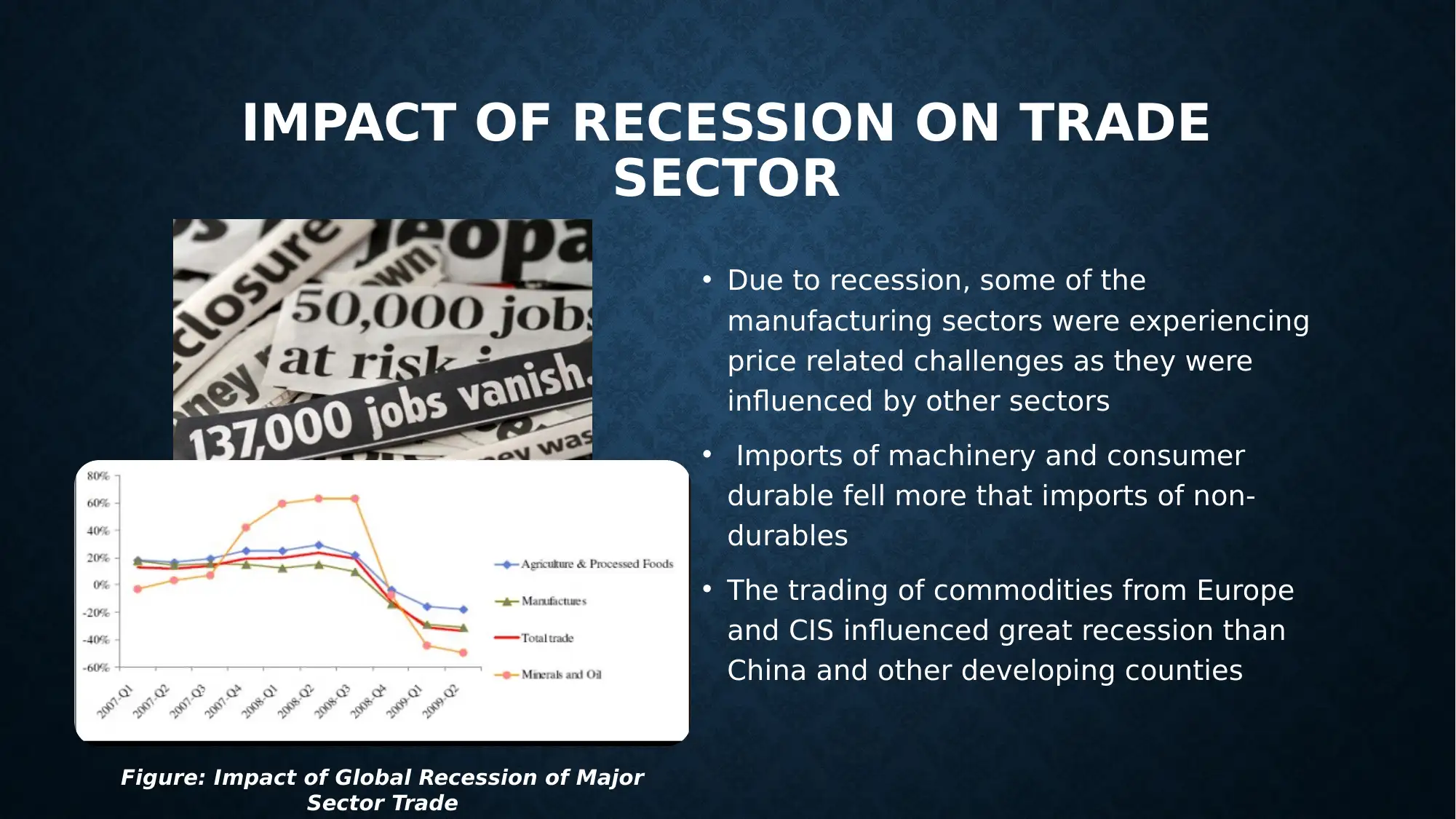
IMPACT OF RECESSION ON TRADE
SECTOR
• Due to recession, some of the
manufacturing sectors were experiencing
price related challenges as they were
influenced by other sectors
• Imports of machinery and consumer
durable fell more that imports of non-
durables
• The trading of commodities from Europe
and CIS influenced great recession than
China and other developing counties
Figure: Impact of Global Recession of Major
Sector Trade
SECTOR
• Due to recession, some of the
manufacturing sectors were experiencing
price related challenges as they were
influenced by other sectors
• Imports of machinery and consumer
durable fell more that imports of non-
durables
• The trading of commodities from Europe
and CIS influenced great recession than
China and other developing counties
Figure: Impact of Global Recession of Major
Sector Trade
Paraphrase This Document
Need a fresh take? Get an instant paraphrase of this document with our AI Paraphraser
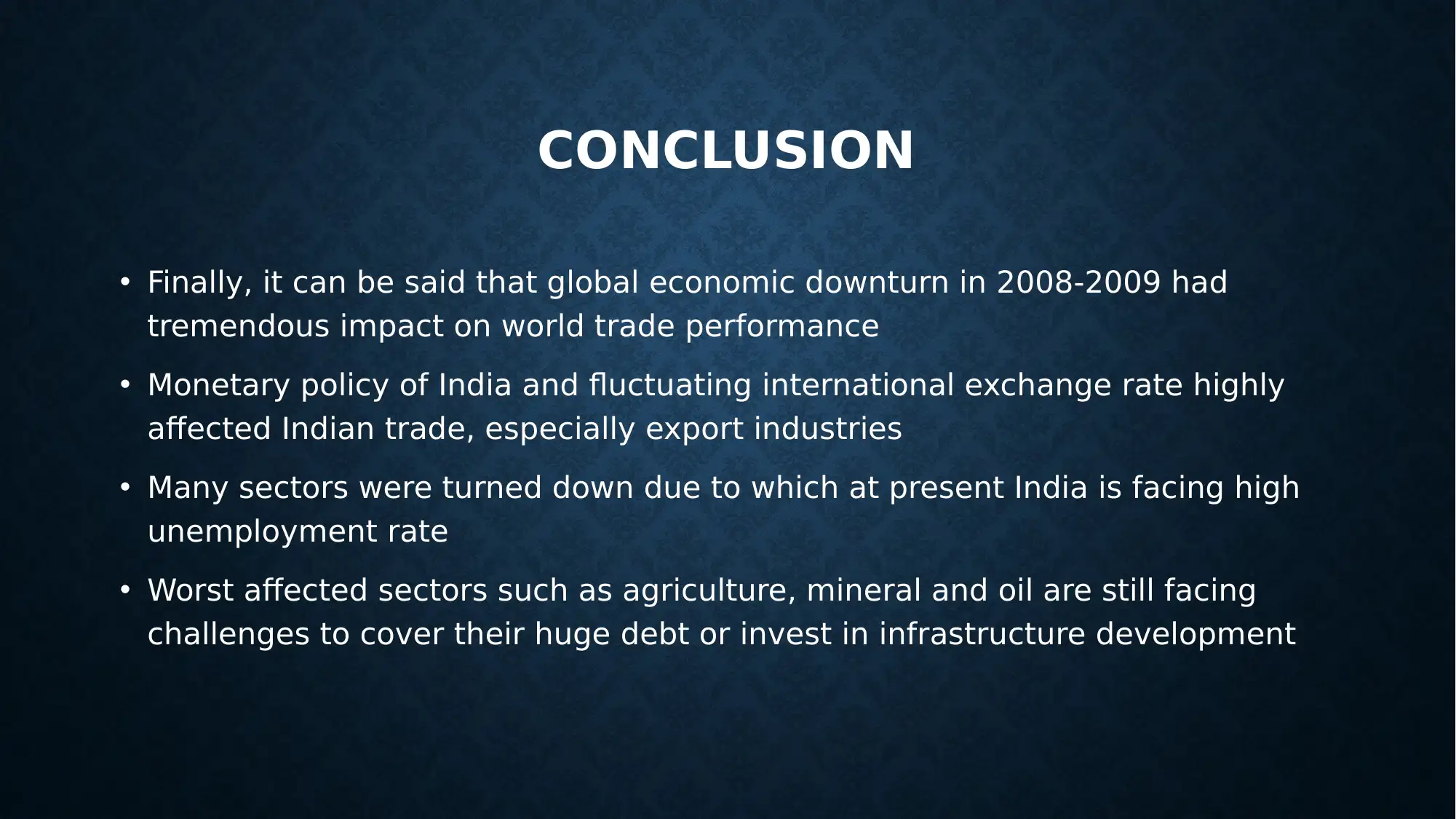
CONCLUSION
• Finally, it can be said that global economic downturn in 2008-2009 had
tremendous impact on world trade performance
• Monetary policy of India and fluctuating international exchange rate highly
affected Indian trade, especially export industries
• Many sectors were turned down due to which at present India is facing high
unemployment rate
• Worst affected sectors such as agriculture, mineral and oil are still facing
challenges to cover their huge debt or invest in infrastructure development
• Finally, it can be said that global economic downturn in 2008-2009 had
tremendous impact on world trade performance
• Monetary policy of India and fluctuating international exchange rate highly
affected Indian trade, especially export industries
• Many sectors were turned down due to which at present India is facing high
unemployment rate
• Worst affected sectors such as agriculture, mineral and oil are still facing
challenges to cover their huge debt or invest in infrastructure development
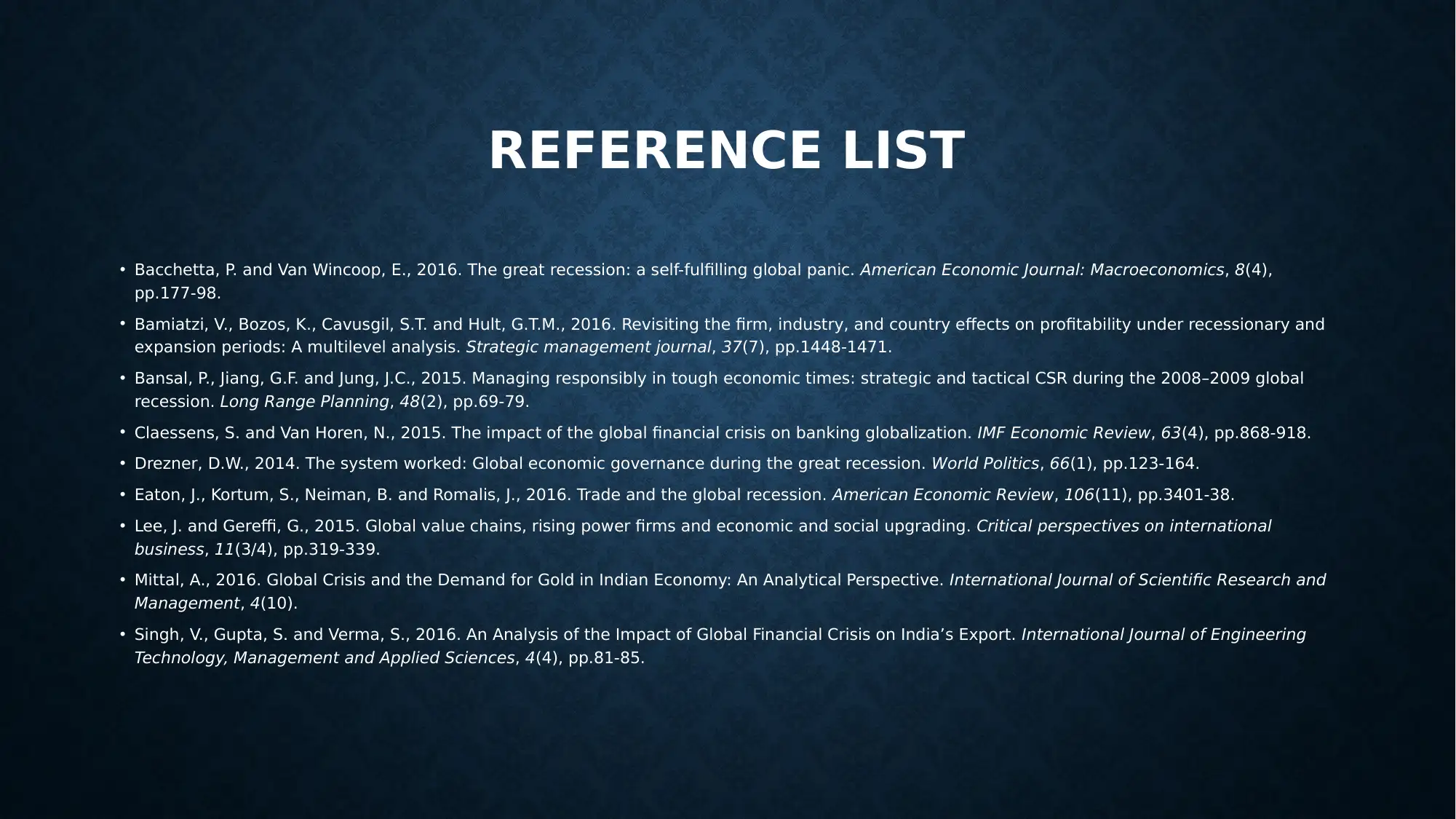
REFERENCE LIST
• Bacchetta, P. and Van Wincoop, E., 2016. The great recession: a self-fulfilling global panic. American Economic Journal: Macroeconomics, 8(4),
pp.177-98.
• Bamiatzi, V., Bozos, K., Cavusgil, S.T. and Hult, G.T.M., 2016. Revisiting the firm, industry, and country effects on profitability under recessionary and
expansion periods: A multilevel analysis. Strategic management journal, 37(7), pp.1448-1471.
• Bansal, P., Jiang, G.F. and Jung, J.C., 2015. Managing responsibly in tough economic times: strategic and tactical CSR during the 2008–2009 global
recession. Long Range Planning, 48(2), pp.69-79.
• Claessens, S. and Van Horen, N., 2015. The impact of the global financial crisis on banking globalization. IMF Economic Review, 63(4), pp.868-918.
• Drezner, D.W., 2014. The system worked: Global economic governance during the great recession. World Politics, 66(1), pp.123-164.
• Eaton, J., Kortum, S., Neiman, B. and Romalis, J., 2016. Trade and the global recession. American Economic Review, 106(11), pp.3401-38.
• Lee, J. and Gereffi, G., 2015. Global value chains, rising power firms and economic and social upgrading. Critical perspectives on international
business, 11(3/4), pp.319-339.
• Mittal, A., 2016. Global Crisis and the Demand for Gold in Indian Economy: An Analytical Perspective. International Journal of Scientific Research and
Management, 4(10).
• Singh, V., Gupta, S. and Verma, S., 2016. An Analysis of the Impact of Global Financial Crisis on India’s Export. International Journal of Engineering
Technology, Management and Applied Sciences, 4(4), pp.81-85.
• Bacchetta, P. and Van Wincoop, E., 2016. The great recession: a self-fulfilling global panic. American Economic Journal: Macroeconomics, 8(4),
pp.177-98.
• Bamiatzi, V., Bozos, K., Cavusgil, S.T. and Hult, G.T.M., 2016. Revisiting the firm, industry, and country effects on profitability under recessionary and
expansion periods: A multilevel analysis. Strategic management journal, 37(7), pp.1448-1471.
• Bansal, P., Jiang, G.F. and Jung, J.C., 2015. Managing responsibly in tough economic times: strategic and tactical CSR during the 2008–2009 global
recession. Long Range Planning, 48(2), pp.69-79.
• Claessens, S. and Van Horen, N., 2015. The impact of the global financial crisis on banking globalization. IMF Economic Review, 63(4), pp.868-918.
• Drezner, D.W., 2014. The system worked: Global economic governance during the great recession. World Politics, 66(1), pp.123-164.
• Eaton, J., Kortum, S., Neiman, B. and Romalis, J., 2016. Trade and the global recession. American Economic Review, 106(11), pp.3401-38.
• Lee, J. and Gereffi, G., 2015. Global value chains, rising power firms and economic and social upgrading. Critical perspectives on international
business, 11(3/4), pp.319-339.
• Mittal, A., 2016. Global Crisis and the Demand for Gold in Indian Economy: An Analytical Perspective. International Journal of Scientific Research and
Management, 4(10).
• Singh, V., Gupta, S. and Verma, S., 2016. An Analysis of the Impact of Global Financial Crisis on India’s Export. International Journal of Engineering
Technology, Management and Applied Sciences, 4(4), pp.81-85.
⊘ This is a preview!⊘
Do you want full access?
Subscribe today to unlock all pages.

Trusted by 1+ million students worldwide
1 out of 13
Related Documents
Your All-in-One AI-Powered Toolkit for Academic Success.
+13062052269
info@desklib.com
Available 24*7 on WhatsApp / Email
![[object Object]](/_next/static/media/star-bottom.7253800d.svg)
Unlock your academic potential
Copyright © 2020–2025 A2Z Services. All Rights Reserved. Developed and managed by ZUCOL.





